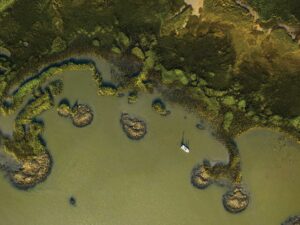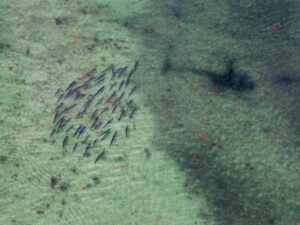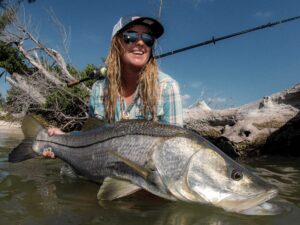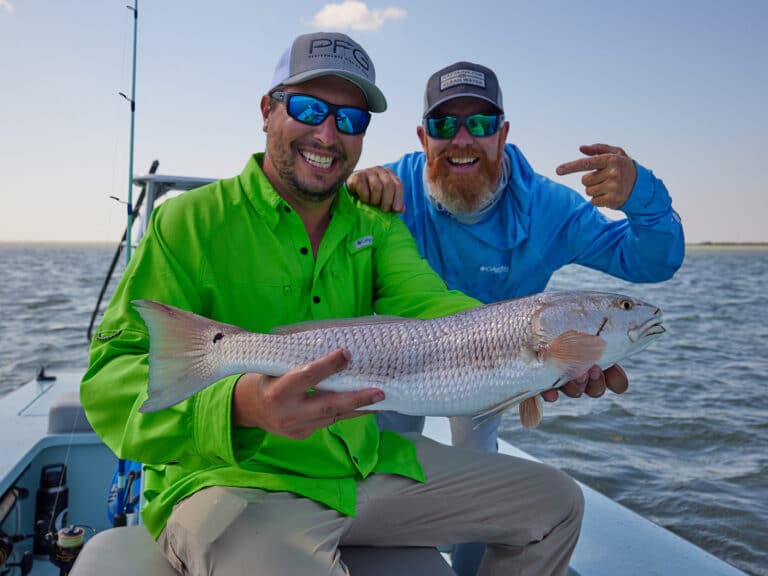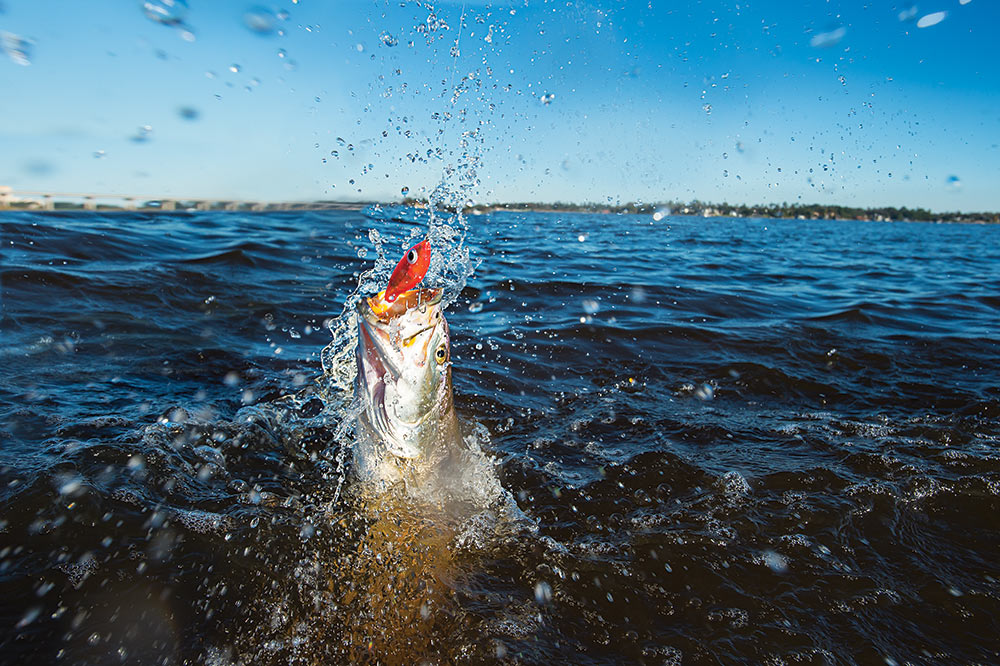
The best and most winning trout fishermen along the Gulf Coast have one thing in common: they fish structure. Reefs, wrecks and rocks, all magnets for baitfish, draw speckled trout from May through November.
Capt. Jerry Norris has been fishing Sabine Lake on the Texas-Louisiana border for more than 40 years. “The middle and upper areas of Sabine Lake are 3 to 7 feet deep. But on the lower end, we have about 100 acres of oyster reef in 10 to 27 feet of water. It holds trout just about year-round. In fact, the cold winter months can be best. But during the fall, it’ll load up with trout, and they are stupid easy to catch on jigs.”
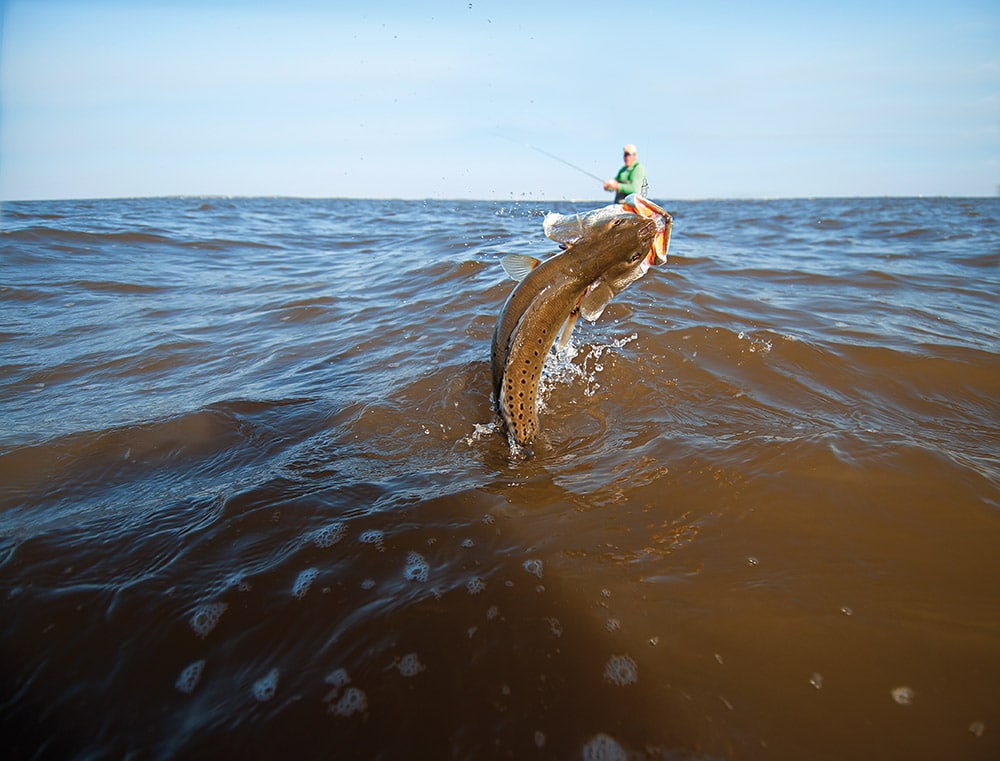
Norris’ favorite jig is a Saltwater Shad Assassin, a 5-inch rat-tail soft plastic. His top color is Red Shad.Rig ’em up with a ¼-ounce jig head and bump them along bottom. Trout hold in the deep part of the reef and come up to ambush shrimp, shad and mullet.
Numbers Game
Another well-known trout producer to the east, Lake Calcasieu has pumped out big numbers of trout for decades.
“We catch probably 80 percent of our trout on the oyster reefs here,” says Capt. Buddy Oaks with Hackberry Rod and Gun. “During the summer, we’ll use live shrimp under a popping cork or with a slip- weight rig on shell bottom in 5 to 8 feet of water.”
Structure-Rich
West Matagorda Bay out of Port O’Connor offers a variety of trout structure. In the middle of the bay sit several natural-gas wells. On the lower end of the bay lie a couple of shrimp-boat wrecks. On the upper end of the bay, spoil banks built up with oyster shell line the ship channel. There is also a man-made reef on this bay that’s about 500 yards long and 100 yards wide. That’s a lot of trout-holding structure, and a lot of variety of habitat, offering abundant options.
 |
Subscribe Now and Save 63% |
Belly Up
About 20 miles south of West Matagorda Bay, San Antonio Bay holds abundant shell reefs and is a go-to hot spot for lots of guides.
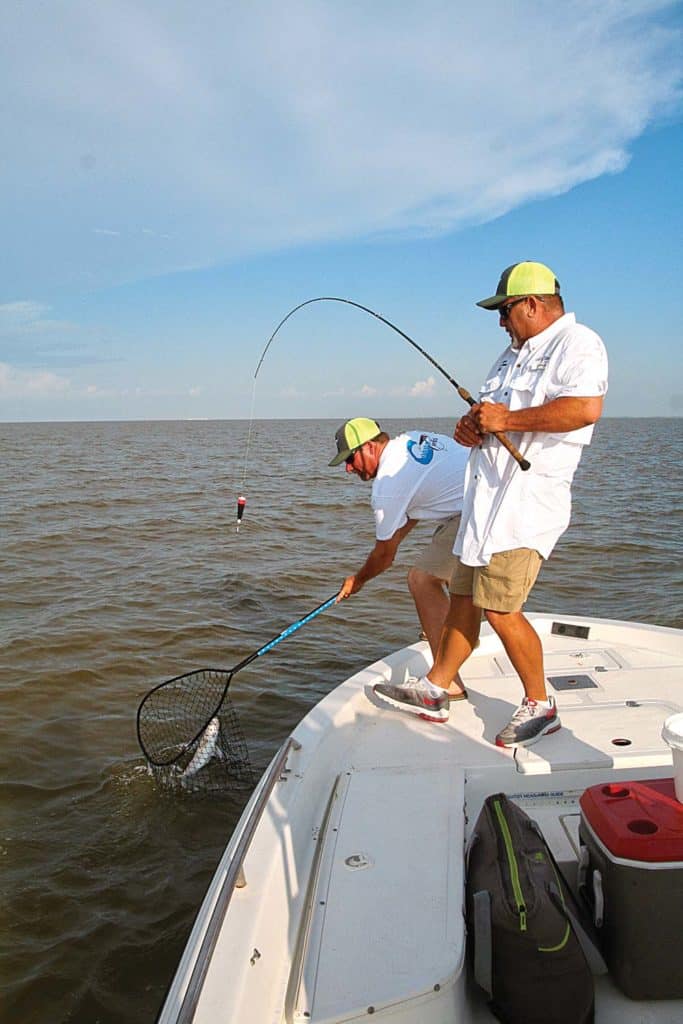
One of the most unusual places I’ve ever fished is Baffin Bay, on the upper end of the Laguna Madre, south of Corpus Christi Bay. This particular bay’s claim to fame is 8- to 12-pound trout it produces each year. It’s probably the No. 1 trophy-trout producer along the entire Gulf Coast. And it’s no secret where those big trout can be caught — around rocks, big and small.
Double-Team
This shallow bay is a hypersaline estuary with no access to the Gulf. Lacking tides, the water level is determined by the wind. But two guides have figured it out, a husband-and-wife team of Capt. Aubrey Black and Capt. Sally Black of Baffin Bay Rod and Gun.
“We drift-fish and wade,” says Aubrey. “Finding big trout is mainly fishing around the rock formations with the right lures.”
One of his go-to lures is a chartreuse Gulp! 4-inch Swimming Mullet. Rather than using the standard ⅛- or 1⁄16-ounce jig head, they designed their own. It's a 1⁄32-ounce screw-lock jig head on a 1/0 Gamakatsu hook. It's called Black's Magic.
"We catch a lot of the trophy trout here on topwaters," says Sally. "A couple of our favorites include the Yo-Zuri 3DB Pencil and the One Knocker Spook. When the big girls want a slow-sinking jig, we use the 1⁄32-ounce jig head. It keeps the tail in front of the fish longer and draws more strikes.
Some of my favorite soft plastics are the Saltwater Assassin 4-inch Sea Shad paddle tails in Mighty White and Sugar and Spice."
As of the first of June last year, Sally reported their guides and clients had caught 167 trout over 25 inches and 14 in the 29- to 31-inch class. That’s about as fine as trout fishing gets along the Gulf Coast.
Wide Open
Expansive man-made reefs dot the Gulf Coast, and they are best fished with a drift sock such as the Lindy Wave Tamer. The spring-open design and flotation keep them off the reef, slow your boat in windy conditions, and allow a slow and quiet drift.
The surf offers another productive option for fishing visible wrecks, especially when the water is clean to the beach. Shrimp-boat wrecks in the surf from Port O’Connor south toward Port Aransas attract baitfish and, in turn, productive fishing for trout in the 2- to 4-pound class. Anchor from the bow and feed out rode until you are within casting distance.
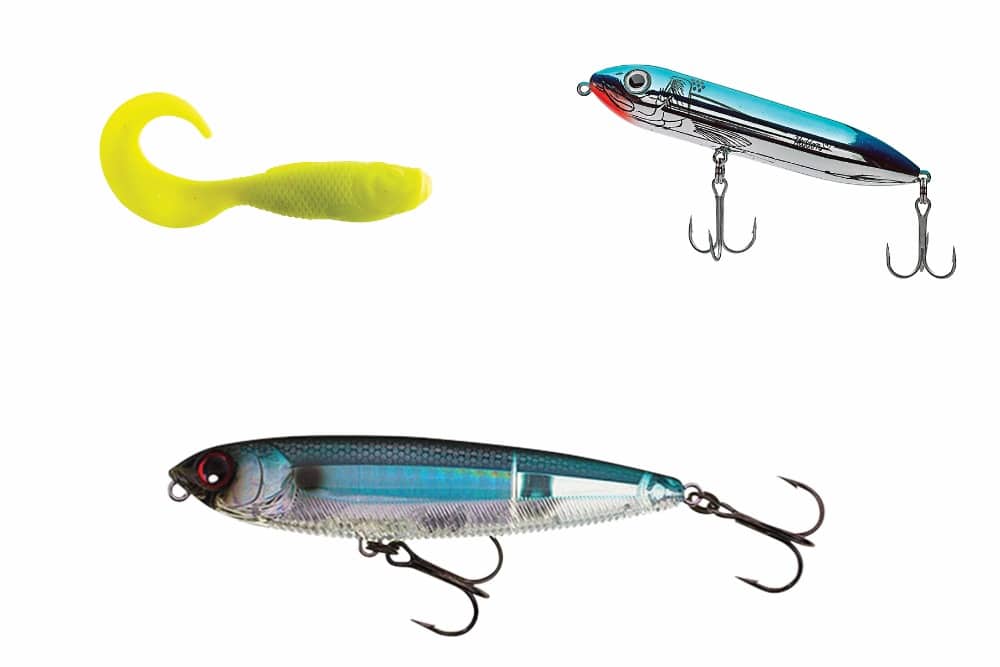
One particularly productive wreck, the Darlington, sits just off Matagorda Island, about 15 miles southwest of the lighthouse. Around the wrecks, top lures include soft plastics such as a Yum Money Minnow, silver spoons and topwaters such as the Super Spook Jr. Topwater lures cover any reef along the Gulf Coast in 5 to 15 feet of water.
Popping corks prove deadly as well over shallow shell and man-made reefs.
Well, Well, Well
Gas and oil-production wells up to 10 miles offshore attract baitfish and schools of trout. The best wells in the bays have a shell pad surrounding them. Fish the wells with live shrimp or croakers under slip corks, or on a Carolina rig. Norris has been fishing them out of Sabine Pass on the Texas-Louisiana border for years.
“We’ve got several rigs about 10 to 12 miles off the Sabine jetties,” he says. “The water is anywhere from 20 to 25 feet deep around them. During the summer, big schools of trout feed around the reef formed by the substructure of the rigs. The best way to catch those trout is with a ¼- or ½-ounce jig head and a soft-plastic tail. And I’ll usually fish a Saltwater Shad Assassin with a vertical presentation in Glow Chartreuse or Red Shad. Most of the time, trout hold tight to the substructure on the down-current side.”
Fishing the reefs, rocks, wrecks and rigs along the Gulf Coast is a surefire tactic that’ll keep you on trout throughout the summer and fall months. It’s relatively easy fishing, and the biggest challenge is where to go first.
Coastal Corks
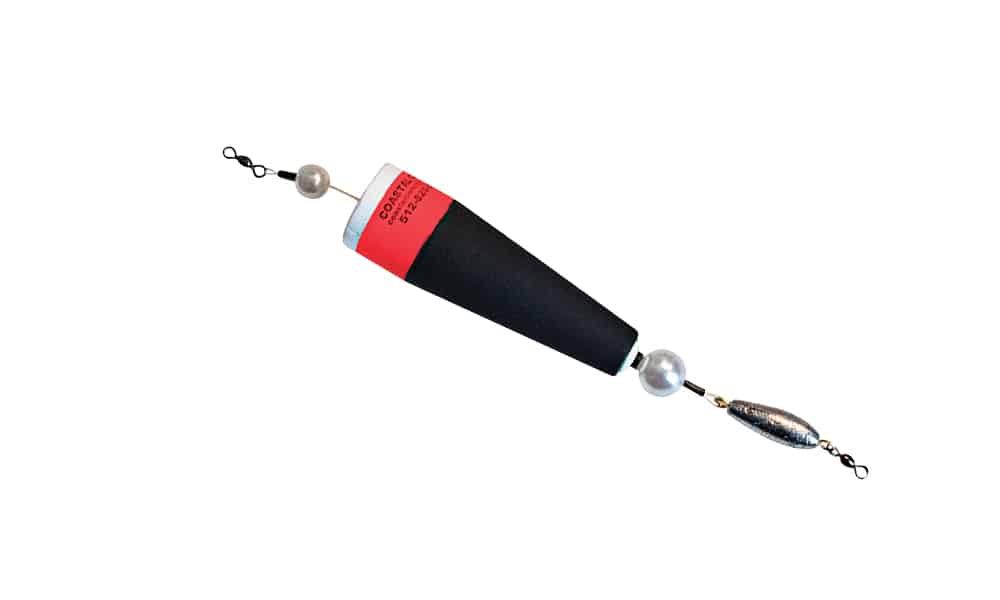
The rigged cone-shaped float from Coastal Corks, available in black, orange, pink or white, comes fitted with monofilament line running through the center and a pearl-white bead on top and bottom. Beneath the lower bead, a pre-rigged lead weight both increases casting distance and helps produce a significant baloop on the retrieve.
On the bottom of the float, tie 24 inches of monofilament leader and add a jig, spoon, or live or dead bait. Here’s how it works: Cast the rig, then pop the cork on the retrieve to cause commotion. Fish investigate the noise, see the bait and eat it. It’s a simple concept that has caught thousands of trout along the Gulf Coast from Mississippi to Texas.
SWS Planner
What: Speckled trout When: May through November Who: Anglers in boats with GPS to numbers of wrecks, reefs and gas and oil wells. The following charter captains know the spots to make your trout trip a success:
Sabine Lake
• Capt. Jerry Norris, 409-718-8782, sabinelakefishing.com
Port O'Connor
• Capt. Robert Sloan, 409-782-6796, sloan288@aol.com, luckystrikeguide.com
Baffin Bay
• Capt. Sally Black, 361-205-0624, baffinbayrodandgun.com
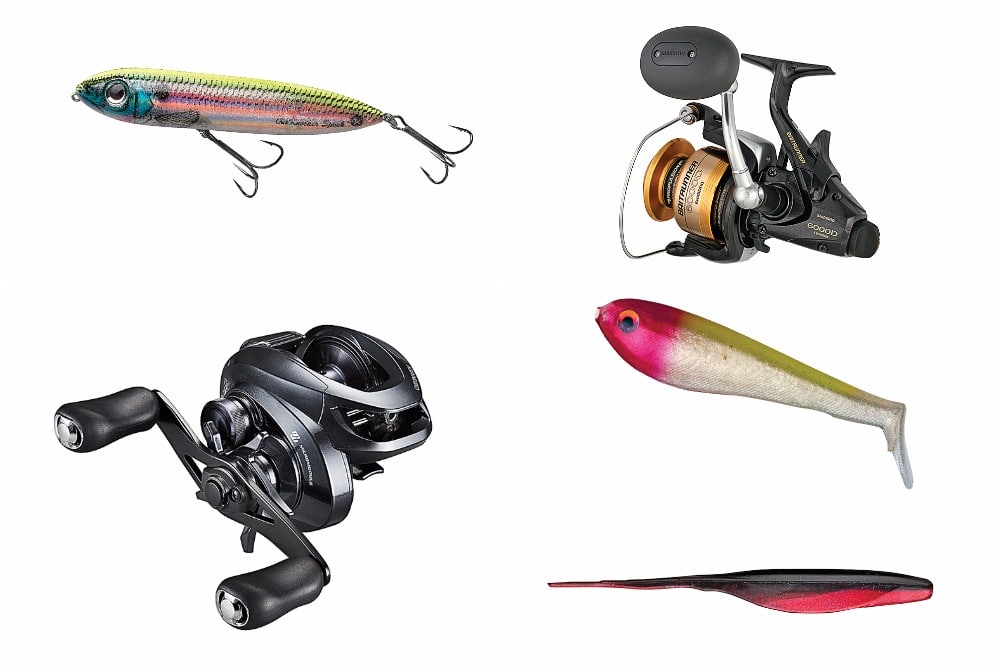
SWS Tackle Box
Rods
• Casting: 6-foot rated for 6- to 12-pound line and 1⁄16- to 1⁄2-ounce lures. • Spinning: 7-foot rated for 8- to 17-pound line and 1⁄4- to 5⁄8-ounce lures.
Reels
• Spinning: Shimano Baitrunner or equivalent. • Casting: Shimano Chronarch C1 or equivalent.
Line
12-pound mono on baitcasting reels, 30-pound braid on spinning reels; 3 feet of 20-pound-test fluoro leader.
Lures
31⁄2-inch Yum Money Minnow on a 1⁄8- or 1⁄4- ounce jig head; Berkley Gulp! 4-inch Swimming Mullet in chartreuse on a 1⁄32-, 1⁄16- or 1⁄8-ounce jig head; Bass Assassin Saltwater Shad in a Red Shad or Glow Chartreuse on a 1⁄4-ounce jig head
Live baits
Shrimp, croakers, mullet and pinfish



